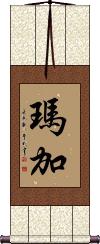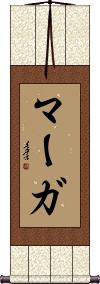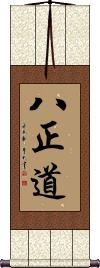Many custom options...
And formats...

Marga in Chinese / Japanese...
Buy a Marga calligraphy wall scroll here!
Personalize your custom “Marga” project by clicking the button next to your favorite “Marga” title below...
Marga
Marga
The Noble Eightfold Path
Ashtangika Marga / Astangika-Marga / Atthangika Magga
八正道 is a complex set of steps that Buddhists much take to cleanse karma, achieve enlightenment, eventually cease the cycle of rebirth and live in a state of Nirvana.
Note: This term is exclusively used by devout Buddhists. It is not a common term and remains an unknown concept to most Japanese and Chinese people. Sometimes written as 八聖道.
See Also: Buddhism | Enlightenment
Not the results for Marga that you were looking for?
Below are some entries from our dictionary that may match your Marga search...
| Characters If shown, 2nd row is Simp. Chinese |
Pronunciation Romanization |
Simple Dictionary Definition |
道 see styles |
dào dao4 tao wataru わたる |
More info & calligraphy: Daoism / Taoism(1) (abbreviation) (See 道・みち・1) road; path; street; route; (2) (See 道・みち・5) way; set of practices; rules for conducting oneself; (3) (abbreviation) (in Japanese schools) (See 道徳教育) moral education; (4) Buddhist teachings; (5) Taoism; (6) administrative region of Japan (Hokkaido); (7) (hist) administrative region of Japan (Tokaido, Tosando, etc.); (8) province (administrative region of Korea); (9) circuit (administrative region of China); (10) (hist) province (Tang-era administrative region of China); (personal name) Wataru mārga. A way, road; the right path; principle, Truth, Reason, Logos, Cosmic energy; to lead; to say. The way of transmigration by which one arrives at a good or bad existence; any of the six gati, or paths of destiny. The way of bodhi, or enlightenment leading to nirvāṇa through spiritual stages. Essential nirvāṇa, in which absolute freedom reigns. For the eightfold noble path v. 八聖道.; The two Ways: (1) (a) 無礙道 or 無間道 The open or unhindered way, or the way of removing all obstacles or intervention, i. e. all delusion; (b) 解脫道 the way of release, by realization of truth. (2) (a) 難行道 The hard way of "works", i. e. by the six pāramitā and the disciplines. (b) 易行道 the easy way salvation, by the invocation of Amitābha. (3) (a) 有漏道 The way of reincarnation or mortality; (b) 無漏 the enlightened way of escape from the miseries of transmigration. (4) (a) 教道 The way of instruction; (b) 證道 the way of realization. (5) The two lower excretory organs. |
四諦 四谛 see styles |
sì dì si4 di4 ssu ti shitai したい |
More info & calligraphy: Four Noble Truths (Buddhism){Buddh} (See 苦集滅道) The Four Noble Truths catvāri-ārya-satyāni; 四聖諦; 四眞諦. The four dogmas, or noble truths, the primary and fundamental doctrines of Śākyamuni, said to approximate to the form of medical diagnosis. They are pain or 'suffering, its cause, its ending, the way thereto; that existence is suffering, that human passion (taṇhā, 欲 desire) is the cause of continued suffering, that by the destruction of human passion existence may be brought to an end; that by a life of holiness the destruction of human passion may be attained'. Childers. The four are 苦, 聚 (or 集), 滅, and 道諦, i. e. duḥkha 豆佉, samudaya 三牟提耶, nirodha 尼棲陀, and mārga 末加. Eitel interprets them (1) 'that 'misery' is a necessary attribute of sentient existence'; (2) that 'the 'accumulation' of misery is caused by the passions'; (3) that 'the 'extinction' of passion is possible; (4) mārga is 'the doctrine of the 'path' that leads to the extinction of passion'. (1) 苦 suffering is the lot of the 六趣 six states of existence; (2) 集 is the aggregation (or exacerbation) of suffering by reason of the passions; (3) 滅 is nirvana, the extinction of desire and its consequences, and the leaving of the sufferings of mortality as void and extinct; (4) 道 is the way of such extinction, i. e. the 八正道 eightfold correct way. The first two are considered to be related to this life, the last two to 出世間 a life outside or apart from the world. The four are described as the fundamental doctrines first preached to his five former ascetic companions. Those who accepted these truths were in the stage of śrāvaka. There is much dispute as to the meaning of 滅 'extinction' as to whether it means extinction of suffering, of passion, or of existence. The Nirvana Sutra 18 says that whoever accepts the four dogmas will put an end to births and deaths 若能見四諦則得斷生死 which does not of necessity mean the termination of existence but that of continued transmigration. v. 滅. |
道諦 道谛 see styles |
dào dì dao4 di4 tao ti doutai / dotai どうたい |
More info & calligraphy: Four Noble Truths: Path Leading Away From Sufferingmārga, the dogma of the path leading to the extinction of passion, the fourth of the four axioms, i.e. the eightfold noble path, v. 八聖道. |
末伽 see styles |
mò qié mo4 qie2 mo ch`ieh mo chieh maga |
mārga; track, path, way, the way; the fourth of the four dogmas 四諦, i. e. 道, known as the 八聖道, 八正道 (or 八正門), the eight holy or correct ways, or gates out of suffering into nirvana. Mārga is described as the 因 cause of liberation, bodhi as its 果 result. |
滅道 灭道 see styles |
miè dào mie4 dao4 mieh tao metsudou / metsudo めつどう |
{Buddh} (See 道諦,滅諦) truths of the cessation of suffering and of the way to the cessation of suffering Extinction of suffering and the way of extinction, nirodha and mārga; v. supra. |
道智 see styles |
dào zhì dao4 zhi4 tao chih michitoshi みちとし |
(male given name) Michitoshi Religious wisdom; the wisdom which understands the principles of mārga, the eightfold path. |
七八行 see styles |
qī bā xíng qi1 ba1 xing2 ch`i pa hsing chi pa hsing shichi hachigyō |
The practice of the seven bodhyaṅga 七菩提分, and the 八正道 eight marga or noble paths. |
道法智 see styles |
dào fǎ zhì dao4 fa3 zhi4 tao fa chih dōhotchi |
The wisdom attained by them; the wisdom which rids one of false views in regard to mārga, or the eightfold noble path. |
八正道經 八正道经 see styles |
bā zhèng dào jīng ba1 zheng4 dao4 jing1 pa cheng tao ching Hasshō dō kyō |
Buddha-bhāṣita-aṣṭaṅga-samyaṅ-mārga-sūtra. Tr. by An Shigao of the Eastern Han B.N.659; being an earlier translation of the Samyuktāgama 雜阿含經. |
苦集滅道 苦集灭道 see styles |
kǔ jí miè dào ku3 ji2 mie4 dao4 k`u chi mieh tao ku chi mieh tao kujuumetsudou; kujumetsudou; kushumetsudou / kujumetsudo; kujumetsudo; kushumetsudo くじゅうめつどう; くじゅめつどう; くしゅめつどう |
the Four Noble Truths (Budd.), namely: all life is suffering 苦[ku3], the cause of suffering is desire 集[ji2], emancipation comes only by eliminating passions 滅|灭[mie4], the way 道[dao4] to emancipation is the Eight-fold Noble Way 八正道[ba1 zheng4 dao4]; also called 四諦|四谛[si4 di4] {Buddh} (See 四諦) Suffering, Source of Suffering Desire, The Cessation of Suffering, The Way Leading to the Cessation of Suffering (The Four Noble Truths of Buddhism) The four axioms or truths: i. e. duḥkha, pain; samudaya, as above; nirodha, the extinguishing of pain and reincarnation; mārga, the way to such extinction; cf. 四諦. |
三十七道品 see styles |
sān shí qī dào pǐn san1 shi2 qi1 dao4 pin3 san shih ch`i tao p`in san shih chi tao pin sanjūnana dōhon |
三十七分法, 三十七菩提分法, 三十七品 The thirty-seven conditions leading to bodhi, or Buddhahood, i. e. 四念處 smṛtyupasthāna, four states of memory, or subjects of reflection; 四正勤 samyakprahāṇa, four proper lines of exertion; 四如意足 ṛddhipāda, four steps towards supernatural power; 五根 pañca indriyāṇi, five spiritual faculties; 五力pañca balāni, their five powers; 七覺支 sapta bodhyaṅga, seven degrees of enlightenment, or intelligence; and 八正道 aṣṭa-mārga, the eightfold noble path. |
The following table may be helpful for those studying Chinese or Japanese...
| Title | Characters | Romaji (Romanized Japanese) | Various forms of Romanized Chinese | |
| Marga | 瑪加 玛加 | mǎ jiā / ma3 jia1 / ma jia / majia | ma chia / machia | |
| Marga | マーガ | maaga / maga | ||
| The Noble Eightfold Path | 八正道 | hasshoudou / hashodo | bā zhèng dào ba1 zheng4 dao4 ba zheng dao bazhengdao | pa cheng tao pachengtao |
| In some entries above you will see that characters have different versions above and below a line. In these cases, the characters above the line are Traditional Chinese, while the ones below are Simplified Chinese. | ||||
Successful Chinese Character and Japanese Kanji calligraphy searches within the last few hours...






